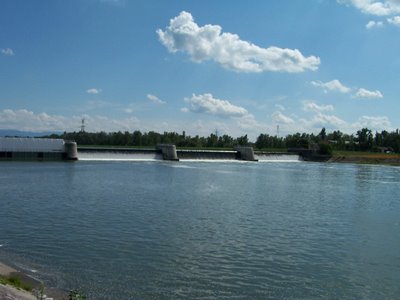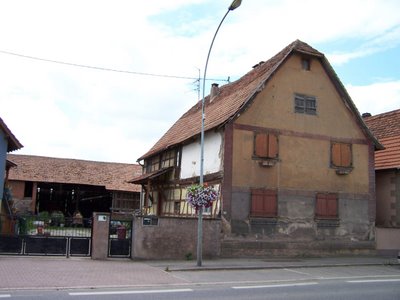Driving Down the Rhine
 Tuesday, August 15 was a holiday in France. Most folks, including Theresa, were out of town. I decided to spend the day driving down the Rhine valley.
Tuesday, August 15 was a holiday in France. Most folks, including Theresa, were out of town. I decided to spend the day driving down the Rhine valley.
Normally, when driving south we take the main highway that runs at the foot of the Vosges. Or at times we've crossed into Germany and taken the roads through the Black Forest. I'd never actually driven through the bottom lands along the river in Alsace.
At first, driving through the farms along the Rhine could easily be confused with driving through Southern Indiana along the Ohio river. Field after field interupted by scrub land and small woods. Lots and lots of corn too. The roads connecting the farming towns are pretty much like the county roads in Posey County, Indiana. You really feel at home when you get stuck in slow traffic behind a tractor.
The crops you pass are a little different. Though corn is the main crop, there are sizeable fields of tobacco and sugar beets and hops. Not so much wheat and cabbage as you see around Strasbourg, but still a little being grown.
You also know you are in Alsace when you drive through the farming towns. The smaller ones on the back roads are frozen in time - moreso than I would have expected. Lots of the half-timbered houses that look to date back a couple of hundred years (if not more). Also, you find that a typical home in the village can have old barns adjoining it at right angles to form kind of a courtyard. This is because people live in the village rather than right next to their fields. They travel out in the morning and have to take everything they need with them. When they return in the evening they bring all their equipment (and I suppose their harvest) with them to store in their barns or to feed the chickens in the courtyard. At one time, they would have brought the horses back in the evenings to put them in the barns. Today, they bring the tractor back into town to park for the night.
Pictures below were show a house in typical farm town. In the first, you can see the barn in the background...but you can't see the building to the far left that completes the courtyard. Next photo was taken peering through the gate into the courtyard. The living quarters is to the left and everything else is stuffed full of hay, straw, and farm equipment.
 Farm towns seem to be sprinkled about every 4 or 5 kilometers. I suppose that this was fixed by the distance that one could travel each day to and from the fields.
Farm towns seem to be sprinkled about every 4 or 5 kilometers. I suppose that this was fixed by the distance that one could travel each day to and from the fields.
Also, every now and then you see a sign pointing to a ferry crossing of the river. Not too long ago these ferries would have been pretty busy all up and down the Rhine, hauling people back-and-forth from the German side. Bridges have taken most of the traffic, I assume, in the areas around Strasbourg and Colmar. It's only in these bottom lands that are distant from the bridges that I've seen the ferry advertised.
Another thing that struck me is that from these farming villages the mountains of the Black Forest stand out on the eastern horizon much closer than the Vosges to the west. For hundreds of years, the people living here were closer to the German culture than that of France. Case in point - it was a lot easier for me to cross over the Rhine than it was to cross over the mountain pass towards St. Dié into old France. (And I had the benefit of an automobile). The people here weren't French and they weren't German. It's easy to see why the Alsatians were able to preserve their language and traditions for so long....and why it was only with the advent of roads and railways in the 20th century that the region could begin to be integrated with France.
Enough of that. Stay tuned for more sites from along the Rhine.

0 Comments:
Post a Comment
<< Home